NavSource Online: Submarine Photo Archive
Foreign Guests
| Click On Image For Full Size | Size | Image Description | Source | |
|---|---|---|---|---|

 Submarine Guests in the U.S. Over The Years
Submarine Guests in the U.S. Over The Years |
||||
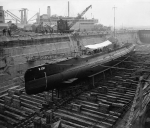 | 240k | The Dutch submarine K-XIII in Mare Island's dry dock #2 on 4 September 1926. The Medusa (AR-1) is in the background. | USN photo courtesy of Darryl L. Baker. | |
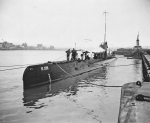 | 66k | The Dutch submarine K-XIII at her berth at Mare Island on 4 September 1926. The tug Active (YT-14) is in the background. | USN photo courtesy of Darryl L. Baker. | |
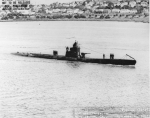 | 155k | Two Ivan WW II subs arrived at the yard on 16 October 1942. For more information see the continuation of this page on wikipedia.org.
Soviet S class submarine.
Type S medium (Russian: Russian: C - Ñðåäíÿÿ)) submarines (unofficially nicknamed Stalinets) were one of the most widely produced and employed submarine class in the Soviet Navy during World War II. Boats of this class were the most successful and achieved most significant victories among all Soviet submarines. They sunk totally 82,770 Gross Register Tonnage (GRT) of merchant shipping and seven warships, which accounts for about one-third of all tonnage sunk by Soviet submarines. The Russian submarine SS-54 is seen departing Mare Island on 11 November 1942. | USN photo # 6696-42, courtesy of Darryl L. Baker. | |
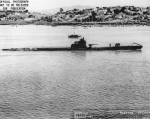 | 151k | The Russian submarine SS-54 is seen departing Mare Island on 11 November 1942. | USN photo # 6697-42, courtesy of Darryl L. Baker. | |
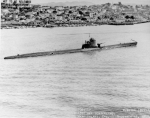 | 254k | The Russian submarine SS-55 is seen departing Mare Island on 11 November 1942. | USN photo # 7001-42, courtesy of Darryl L. Baker. | |
 Italy
Italy |
||||
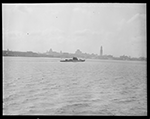 | 94k | Five photo PDF of the Italian submarine Balilla at Boston Harbor, 1 May 1933. | Photo # 08_06_006668, courtesy of the Boston Public Library, Leslie Jones Collection via digitalcommonwealth.org | |
 The Netherlands
The Netherlands |
||||
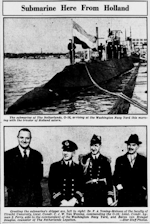 |
NR | Submarine Here From Holland The submarine of The Netherlands, O-16, arriving at the Washington Navy Yard this morning with the tricolor of Holland astern. Greeting the submarine's skipper are, left to right: Dr. F. A. Vening-Meinesz of the faculty of Utrecht University, Lieut. Comdr. C. J. W. Van Waning, commanding the O-16; Lieut. Comdr. Lyman S. Perry, aide to the commandant of the Washington Navy Yard, and Baron van Breugel Douglas, counselor of The Netherlands Legation. |
Image and text provided by Library of Congress, Washington, DC. Photo & text by Evening Star. [volume] (Washington, D.C.) 1854-1972, 15 February 1937, Image 21, courtesy of chroniclingamerica.loc.gov. | |
  United Kingdom
United Kingdom |
||||
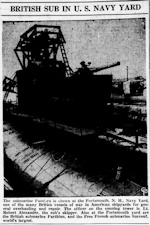 |
NR | BRITISH SUB IN U. S. NAVY YARD The submarine Pandora is shown at the Portsmouth, N.H., Navy Yard, one of the many British vessels of war in American shipyards for general overhauling and repair. The officer on the conning tower is Lt. Robert Alexander, the sub's skipper. Also at the Portsmouth yard are the British submarine Parthian, and the Free French submarine Surcouf, world's largest. |
Image and text provided by University of North Carolina at Chapel Hill Library, Chapel Hill, NC. Photo & text by The Wilmington Morning Star. (Wilmington, N.C.) 1909-1990, 05 October 1941, Section Two, Image 16, courtesy of chroniclingamerica.loc.gov. | |
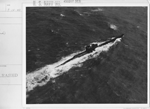 | 978k | She was commissioned on 5-8-24; WW II patrols off Norway during December 1939 and February 1940. She was heavily depth charged off Danish coast. She was sent to Philadelphia, PA. on 22 February 1943 for refit; then used as trainer from Mar 1943 at Halifax, Canada. After the war she was sold to metal industries Montreal in 1946 for scrap, but broke adrift under tow & foundered off the coast of Nova Scotia. HMS L-23 undergoing training in North American waters on 12 September 1943. Both boats remained in RN service, but operated out of Canada after 1943. They were sent there by the RN to train RCN forces in ASW. Canada did not operate submarines during the war. Note the boat's marking as N-23 | US National Archives photo # 80G-450207 from NARA, College Park, Maryland, courtesy of Sean Hert. Photo i.d. courtesy of David Johnston & John Hummel, USN (Retired). | |
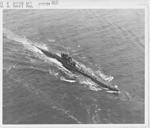 | 952k | HMS L-23 undergoing training in North American waters on 12 September 1943. | US National Archives photo # 80G-450194 from NARA, College Park, Maryland, courtesy of Sean Hert. Photo i.d. & text courtesy of David Johnston & John Hummel, USN (Retired). | |
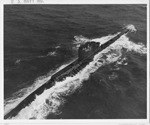 | 852k | HMS L-23 undergoing training in North American waters on 12 September 1943. | US National Archives photo # 80G-450208 from NARA, College Park, Maryland, courtesy of Sean Hert. Photo i.d. courtesy of David Johnston & John Hummel, USN (Retired). | |
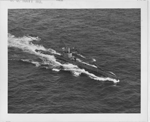 | 925k | HMS Sea Wolf; commissioned in 1935 and scrapped in Montreal, Novemeber 1945. Note the boat's marking as N-47 | US National Archives photo # 80G-40216 from NARA, College Park, Maryland, courtesy of Sean Hert. Photo i.d. courtesy of David Johnston & John Hummel, USN (Retired). | |
 | 925k | Saratoga (CV-3) then took leave of the main theaters of the Pacific war for almost a year, to carry out important but less spectacular assignments elsewhere. Her first task was to help the British initiate their carrier offensive in the Far East. On 4 March, Saratoga departed Majuro with an escort of three destroyers, and sailed via Espiritu Santo; Hobart, Tasmania; and Fremantle, Australia, to join the British Eastern Fleet in the Indian Ocean. She rendezvoused at sea on 27 March with the British force, composed of carrier, Illustrious, and four battleships with escorts, and arrived with them at Trincomalee, Ceylon, on 31 March. On 12 April, the French battleship, Richelieu, arrived, adding to the international flavor of the force. During the next two days, the carriers conducted intensive training at sea during which Saratoga's fliers tried to impart some of their experience to the British pilots. On 16 April, the Eastern Fleet, with Saratoga, sailed from Trincomalee, and, on the 19th, the aircraft from the two carriers struck the port of Sabang, off the northwest tip of Sumatra. The Japanese were caught by surprise by the new offensive, and much damage was done to port facilities and oil reserves. The raid was so successful that Saratoga delayed her departure in order to carry out a second. Sailing again from Ceylon on 6 May, the force struck at Soerabaja, Java, on 17 May with equally successful results. Saratoga was detached the following day, and passed down the columns of the Eastern Fleet as the Allied ships rendered honors to and cheered each other. 23 April 1944: HMS Taciturn and another T class submarine that picked up Lt.(JG) Dale C. Klahn off Sabang, Sumatra. Photo taken from the Saratoga. | Text courtesy of DANFS. USN photo # 80-G-385066 from National Archives and Records Administration (NARA), College Park, Maryland, courtesy of Sean Hert. Insert photo courtesy of ww2online.org |
|
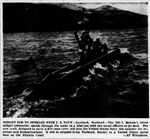 | NR | MIDGET SUB TO OPERATE WITH U. S. NAVY Gareloch, Scotland. — The XE-7, Britain's latest midget submarine, speeds through the water in a trial run with two naval officers on its deck. The new craft, designed to carry a five-man crew, will join the United States Navy this summer for exercises and demonstrations. It will be shipped from Portland, Dorset, to a United States naval base on the Atlantic Coast. | AP Wirephoto. Image and text provided by Library of Congress, Washington, DC. Photo & text by Evening Star. Evening Star. [volume] (Washington, D.C.) 1854-1972, 29 April 1950, Image 4, courtesy of chroniclingamerica.loc.gov. | |
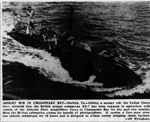 | NR | MIDGET SUB IN CHESAPEAKE BAY — Norfolk, Va. — Lifting a secrecy veil, the United States Navy revealed that the British midget submarine XE-7 has been engaged in operations with vessels of the Atlantic Fleet Amphibious Force in Chesapeake Bay for the past two months. Here the 50-foot submarine cruises for benefit of photographers. It carries a four-man crew, can remain submerged for 24 hours and is designed to attack enemy shipping inside harbors. | AP Wirephoto. Image and text provided by Library of Congress, Washington, DC. Photo & text by Evening Star. Evening Star. [volume] (Washington, D.C.) 1854-1972, 30 August 1950, Image 5, courtesy of chroniclingamerica.loc.gov. | |
 France
France |
||||
 | 527k | French submarine Redoutable, port side, underway, unknown location, WWII. | Photograph # 19-LCM-626-Redoubtable, now in the collections of the National Archives, courtesy of National Museum of the U.S. Navy via flickr.com. | |
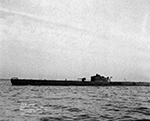 | 780k | French submarine Argo, surface bow view at the Philadelphia Navy Yard, Philadelphia, Pennsylvania, 29 March 1944. | Photograph # 19-LCM-65614, now in the collections of the National Archives, courtesy of National Museum of the U.S. Navy via flickr.com. | |
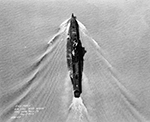 | 711k | Six views (PDF) of French submarine Perle, air view, dead astern, vertical air view "overhead", surface view, stern, off the Philadelphia Naval Yard, Philadelphia, Pennsylvania, between 17 May & 5 June 1944. | Photograph # 19-LCM-65794, now in the collections of the National Archives, courtesy of National Museum of the U.S. Navy via flickr.com. | |
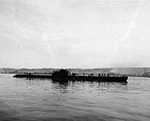 | 603k | French submarine Casabianca (Q183), starboard view with crew on deck, unknown location. Photographed 9 through 23 June 1944. | Photograph # 19-LCM-Box-626-Casablanca, now in the collections of the National Archives, courtesy of National Museum of the U.S. Navy via flickr.com. | |
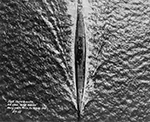 | 907k | French submarine Casabianca (Q183), dead on vertical view, while at Philadelphia Navy Yard, Philadelphia, Pennsylvania, 20 February 1945. She was at Philadelphia after being hit by "friendly fire" by a British plane. | Photograph # 19-LCM-80396, now in the collections of the National Archives, courtesy of National Museum of the U.S. Navy via flickr.com. | |
Additional Resources and Web Sites of Interest
Dutch Submarines
The Soviet Navy
L Class Submarines
| Back To The Main Photo Index | Back To the Submarine Index |
| Problems and site related matters, E-mail Webmaster |
| This page was created by Darryl L. Baker & Michael Mohl, and maintained by Michael Mohl All Pages © 1996 - 2023, NavSource History All rights reserved. |